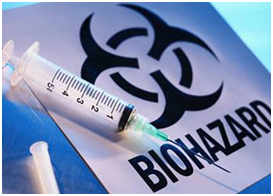Medical Waste Management

At one point, it happens to all of us. We get bored of twiddling our thumbs waiting for our doctor so we look around the room hoping to find something of interest. Our eyes stop on a red box hanging on the wall. We try to decipher what the box is when suddenly the angle of lighting outlines the contents inside. Our eyes widen in horror to see the silhouettes of hundreds of sharp needles nesting within. Although the image mirrors a scene from one of the Saw movies, the reality is that the little box of terrors is none other than a medical waste management procedure.
Medical waste management is simply the regulations, resources, and processes involved in the safe disposal practices in medical fields. Medical waste differs from everyday waste materials in that medical waste involves “diagnosis, treatment, or immunization of human beings or animals,” other biohazardous materials. If an item has the potential to be infectious or harmful to the public, the object should be treated as contaminated and disposed of in the proper containers or facilities with the proper procedures.
An example of a medical waste resource is the ominous “red box” also known as a sharps container. To avoid accidental injuries and spread of disease or infection, this container is used to hold objects that come in contact with blood or other bodily fluids. The sharps container must have a wide enough lid to dispose of and seal in used materials, be thick and strong enough to resist punctures, and be leak proof. The box must also abide by the color codes and appropriate identification label. The container is then transported to an outside company that accurately decontaminates and disposes of the substances inside.
 Picking a proper waste management treatment facility to dispose of medical waste is needed to ensure public safety. Waste management facilities should be properly permitted and registered with the corresponding enforcement agencies to guarantee the company behaves under standard and sterile practices. Each person operating within the facility should have a permit registered under their name and necessary information. This permit should be on their person at all times to show to inspectors and other authority figures when asked. Medical waste treatment facilities should keep records on individual staff members along with what type of waste facility the company is, operating records, and what medical waste contents are received and from which medical facilities submits them.
Picking a proper waste management treatment facility to dispose of medical waste is needed to ensure public safety. Waste management facilities should be properly permitted and registered with the corresponding enforcement agencies to guarantee the company behaves under standard and sterile practices. Each person operating within the facility should have a permit registered under their name and necessary information. This permit should be on their person at all times to show to inspectors and other authority figures when asked. Medical waste treatment facilities should keep records on individual staff members along with what type of waste facility the company is, operating records, and what medical waste contents are received and from which medical facilities submits them.
A medical waste management program should be implemented into medical facilities and in constant communication with related waste management facilities. Medical waste programs include receiving cooperation between medical waste generators and treatment facilities, inspecting equipment and disposal methods, registering and receiving permits with corresponding waste management companies, and compliance with all rules and standards.
Medical waste management tactics are applied in small or large scale levels. Each individual strategy is used to warrant a cleaner and safer environment. The next time you see the red box while you’re waiting in the doctor’s office, take comfort in knowing that your safety was viewed as a top priority.
